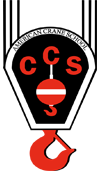Training Resource | Crane Operator Training
How To Pass The Crane Operator Certification Practical Exam
The crane operator certification practical exam (hands on) consists of 4 tasks
1. Place overhead ball in stop circle (optimum time 1:30)
2. Follow hand signals (not timed)
3. Place overhead ball in two barrels (optimum time 3:30)
4-A. Negotiate zigzag corridor with test weight in forward fashion
4-B. Negotiate zigzag corridor with test weight in reverse fashion
Video 1
Video 2
Video 3
(optimum time 3:00 each way swing cab telescopic boom crane)
(optimum time 4:00 each way fixed cab telescopic boom crane)
Videos
working cranes near powerlines: crane accident
anti two block: crane accident
rigger worker: crane accident
worker struck by counterweight crane accident avoid pinch points
rigger struck by rigging
Crane Selection
Before taking the exam it is important to select the right type of crane, for the category in which you choose to be certified on. The national crane operator certification test breaks these categories down into two categories:
1. Fixed cab telescopic boom crane (previously referred to as less than 17.5 tons)
2. Swing cab telescopic boom crane (previously referred to as more than 17.5 tons)
(there is no minimum or maximum tonnage regarding crane operator certification)
The way in which the crane is set up in reference to the test course can make a significant difference. There are many factors that are taken into consideration in the layout process by the testing company, but the most important one is the maximum boom length of the crane. Typically the layout of the course is based on 70%-75% of the boom length on the crane being used. The course is laid out based on the boom angles of the crane, so the longer the maximum the boom length on the crane the more difficult the test will be. This is one of the unique circumstances when “bigger or newer is not necessarily better.”
When selecting a crane that you wish to take your practical exam on it is assumed that you would like to keep it as simple as possible. If that were the case an older crane with less capacity would most likely be the best bet. The older cranes might not run as smoothly but generally they had shorter boom lengths than the newer ones which would mean the test course and the 55 gallon barrels would be much closer to you than on a newer crane of the same capacity. The older cranes also seemed to be built a lot stouter; this would mean that the booms would have a little less deflection in them (less shaky) than the newer cranes of similar capacity with longer booms.
Your last consideration would probably be to select which type of crane to do your test on.
California Crane School has conducted thousands of practical tests on many types of cranes and
the best luck for the fixed cab telescopic boom crane has always been on the boom truck as opposed
to a carrydeck (table crane). As far as the swing cab crane, a truck crane or a rough terrain crane
is concerned, we have not found there to be a significant difference in testing results.
California Crane School
uses many cranes in our training and testing process, which are all Cal OSHA, certified. These cranes are used
exclusively for the training and testing for crane operator certification.
Test weight selection
When the cad drawings are designed for how a crane is to be set up in reference to the test course, another important factor
is the diameter of the test
weight. The test weight diameter can range anywhere from 2’-4’ diameter. In this case as well, bigger is definitely not better.
The course size is adjusted based on the diameter of the test weight and the course is designed to give you two feet on each side of the
test weight between the poles to maneuver through the test course. The size of the start and stop circle, however, always remains the same 6’
diameter, which makes landing a 2’ diameter test weight into the circle much easier than landing a 4’ diameter test weight into that circle.
The weight in the test weight ranges between 20%-30% of the single line pull of the crane, but nothing can be done about this.
California Crane School only uses 2’ diameter test weights for crane operator certification training and testing.
Tennis balls on poles
Although not that important but slightly helpful is the option of the testing company allowing practical examiners to use a 12’ nylon string to
attach the ball onto the pole so a lazy examiner or proctor does not have to fetch the tennis balls when they fall off of the cones. This practice
makes it more convenient for the practical examiner or proctor. However, this is not advantageous to the candidate that is being tested. When the cone
is starting to lay over and the ball falls off the pole, that impact is sometimes enough to knock the pole completely over, resulting in a much
more significant point loss than just knocking down a tennis ball.
California Crane School does not use the services of lazy practical examiners and proctors we make them chase the tennis balls.
Before you start your crane practical exam
Your practical exam begins the minute you sign your score sheet. You will be given a 15-minute familiarization period, where you are not allowed to shadow the zigzag corridor or barrels with the headache ball. This is just a time where you must stay in a designated area and familiarize yourself with the functions on the crane excluding telescoping.
You will also get another 5-minute familiarization period with the test weight in a designated area before you start task 4: Negotiate zigzag
corridor with test weight. Keep in mind you can practice as much as you want with the crane, the test weight and the test course before you sign your
score sheet or before your test begins. This can also help you achieve positive results on your crane practical exam.
California Crane School offers extra practice time with cranes
and an instructor at a rate of $100 per hour.
Most common excuses
you should avoid using
1. The crane is too shaky.
That crane was standing perfectly still before you got on it.
2. We always use taglines at work. Why can’t we use taglines
on the test weight during the test?
This test is not designed for tagline operator certification,
but a crane operator certification.
3. We only use a crane from time to time. Why do we have to go through
all this crane operator certification?
Because Cal-OSHA says you do. 5006.1
(Cal- OSHA 5006.1
Questions & Answers) 5006.1
enforcement
4. Why is there a time limit on the crane test when at work we can go
as slow as we want just as long as we operate the crane safely?
Sure we would all like to sit around and wait for the load to
stop swinging every time you perform a function but you are not
at work. You are performing a test that is designed to assess your
abilities as a crane operator.
Crane Video 2
Frequently Asked Questions (Crane Practical Exam)
1. If I take my crane operator certification practical exam on a
little Grove
18 ton rough terrain crane am I certified to operate a
1,200 ton crane?
Yes! California Crane School does not set the standards. We are simply
the ones that get you to meet them. Once you are certified you have
met the minimum requirement. However, this does not mean that you
are a super duper crane operator.
2. Is it better to knock more balls off the poles and
do the crane practical exam test course fast, or is it better to
take my time and not knock over anything?
This is a difficult question to answer. We have seen crane operators
knock over a lot of things with fast times and pass. We have also
seen crane operators not knock anything over but take too long and
fail. There is a balance. The best thing to do is stay within the
time limits (try not to knock anything over).
3. What is the best way to practice if I want to pass the crane operator certification practical test.
Most candidates just want to practice playing with the practical exam test course or putting the headache ball into the barrels. This could help you if you have already mastered the 5-gallon bucket of water trick. But if you haven’t learned how to control the load this is a waste of time.
For fastest results this is it:
Step 1
Get a 5-gallon bucket
Step 2
Hang the bucket on the hook (the crane should be reeved with
a single part line)
Step 3
Fill the bucket almost to the top with water.
Step 4
Practice swinging the crane left and right until you can use
half throttle and the swing function or lever is fully engaged.
Then bring it to a complete stop without spilling the water or setting
it on the down.
Step 5
Practice lowering and raising the boom until you can use half
throttle and the swing function or lever is fully engaged. Then
bring it to a complete stop without spilling the water or setting
it on the down.
Step 6
Combine step 4 and 5 until you can use both of the functions
simultaneously without spilling the water.
4. What if the load starts to swing into a circular
motion?
If the load starts to go into a circular motion stop one movement
at a time;
first the side to side motion, second it will only swing in and
out, then you can stop the back and forth motion by lowering and
raising the boom.
5. How would I practice if I did not have access to a crane, or what can I do to learn the concepts of how a crane operates before I get into the seat?
(Poor Man's Crane Training)
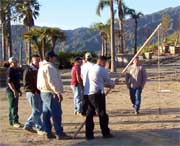
Step 1
Get a pole approximately 8’ long
Step 2
Tie a string approximately 4’ long to the end of the pole
Step 3
Tie a heavy nut or bolt at the end of the string.
Step
5
Put the end of the pole on the ground and practice swinging
it around until you learn the concept of how a crane operates and
controlling the load .
This may sound strange and you might look stupid doing it so don’t let anyone see you they might laugh at you. But it works.
6. What is the trick for task 1 place overhead ball in stop circle?
First you must know how to control the
headache ball (overhaul ball). Swing from the start circle
to the stop circle. When you have the headache ball under control,
don't stop and stare at it, drop it down in the circle without
letting the headache ball (overhaul ball) and chain make any contact
with the test course, without letting the hook make contact
with the ground.
Hint 1
When practicing try to remember the boom
angle of where the stop circle was located.
Hint 2
Keep in mind, the clock is ticking.
(optimum time 1:30)
7 . Which hand signals that will be used on the crane operator
certification practical exam?
You should familiarize with all of the crane
hand signals but the ones that will be the most important
for the practical exam are:
(this task is not timed)
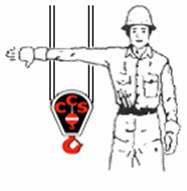 LOWER THE BOOM & RAISE THE LOAD |
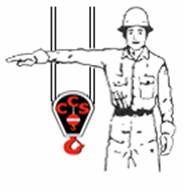 SWING |
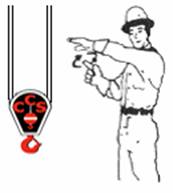 MOVE SLOWLY |
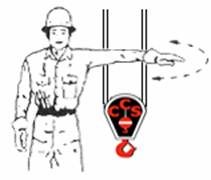 STOP |
8. What is the trick for task 3 placing the headache ball (overhaul
ball) into the barrels?
Again like in task 1, you must know how to control
the headache ball (overhaul ball). Swing from the start
circle to barrel number 1. When you have the headache
ball under control , don't stop and stare at it, drop it
down into the barrel where the white stripe on the ball goes below
the rim of the barrel without knocking the barrel over or moving
the barrel more than 2" (it is ok if the hook or headache
ball make contact with the barrel). Then when you are given the
signal, proceed to barrel number 2 and do the same thing your
time will stop when the headache ball is removed from barrel number
2.
Hint 1
when practicing try to remember the boom
angle of where the barrels were located.
Hint 2
Keep in mind, the clock is ticking.
(optimum time 3:30)
9. What is the trick for getting through tasks 4A and 4B the Zigzag
corridor?
Again like in task 1and 3 you must know how to control
the load . There are point deductions for everything you
knock over, if the load touches the ground, if the 3' chain attached
to the bottom of the test weight leaves the ground, and if you
go over your optimum time.
Hint 1
If you are not an experienced crane operator ar you are not
familiar with the crane don't show everyone how cool you are using
all of the cranes functions at the same time. Use one function at
a time but don't let the load stand still, keep
the load under control and moving through the course. There
is plenty of time if you can control the
load and this 1 function at a time method is used (this
will ensure that because you might be nervous you do not grab
for the wrong function).
Hint 2
When you are on the way out of the course on task 4B do not
get nervous at the end. Many times crane operators get nervous
at the very end of the crane practical exam test course and mess
up what could have otherwise been a good run.
Hint 3
It's understandable that you are nervous.
If you loose control of the load :
Stop
Think
Act
do not immediately react or you might just make it worse.
This will ensure crane safety and successful completion of your crane practical examination.
(optimum time 3:00 each way swing cab telescopic boom crane)
(optimum time 4:00 each way fixed cab telescopic boom crane)
This information is courtesy of California Crane School (if applied) it will ensure success on your crane operator certification practical exam.
